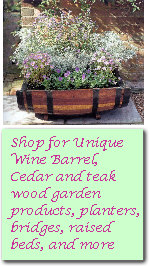If you as a gardener do four things right, your container
garden will give you spectacular success: select the right container, use the
proper soil, select the right plant for your site, and use simple maintenance
procedures.
Select Right Container
A good container should be large enough to provide room for
soil and roots, have sufficient head room for proper watering, provide bottom
drainage, and be attractive without competing with the plant it holds.
Drainage holes are the secret to success by making sure the
plant never stands in wet soil. Roots require air space in the soil to live. If
the desired container does not have drainage holes, consider growing the plant
in another container, perhaps a plastic pot, and displaying it in the more
attractive container.
Size and appearance of the container should be in visual
proportion to the plants grown in it and the setting where it is used. Avoid
excessively heavy containers on balconies and display shelves. The container
should also be of a compatible color and design or style for the setting where
it is to be used. Planter containers may be constructed
with different material, if you are looking for a rustic looking one, look no
further than log wood planter, Cedar Planter
Containers, or the Bamboo planter.
Use the Proper Soil
The potting soil, or medium in which a plant grows, must be of
good quality. It should be porous for root aeration and drainage, but also
capable of water and nutrient retention. Most commercially prepared mixes are
termed artificial, which means they contain no soil; therefore, no insects,
diseases, or weeds.
Select the Right Plant
Trees, shrubs, flowers, vegetables, and herbs do well in
containers. The important thing to remember is that growing a plant in a
container does not change its basic light or moisture requirements. Sun-loving
plants still need to be in full sun.
Growing plants together that have the same light and moisture
requirements adds interest and beauty to the container garden. Avoid mixing
slow-growing and vigorous plants. Avoid selecting a plant that is too small for
the container as the roots will not become established well, and the plant will
never be vigorous.
Use Simple Maintenance Procedures
The most common problem with container gardens is too little
or too much water. Because the volume of soil is relatively small, containers
can dry out very quickly, especially on a concrete patio in full sun. Daily, or
even twice daily watering may be necessary.
Learn to use your fingers to gauge the need for water, then
apply enough to run through the drainage holes in the bottom of the container.
This assures that the soil is thoroughly and uniformly wet and that excess salts
are washed from the soil. On an upstairs balcony, this may mean neighbor
problems, so make provisions for water drainage. However, DO NOT ALLOW THE POT
TO SIT IN WATER. It will cause root damage because there will be no oxygen in
the soil, and it will cause a build-up of salts that can be toxic to plants.
![]() Gardeners' Corner
Kids'
Garden
Sustainable Garden
Contact Us
Gardeners' Corner
Kids'
Garden
Sustainable Garden
Contact Us![]()

